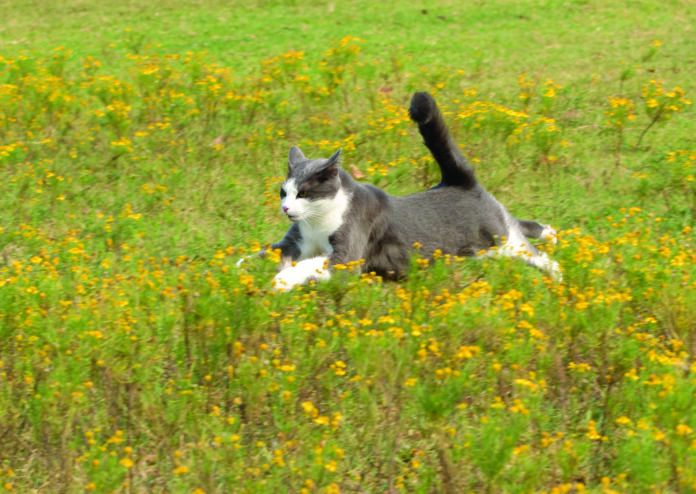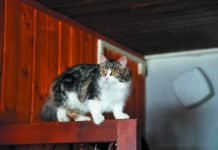Were you aware that cats walk by moving the front and back legs on one side, then moving the front and back legs on the other? It’s thought that allows them to progress more quietly and escape predators’ notice; each hind paw steps almost exactly where the forepaw stepped, minimizing noise and footprints. There are actually a number of ways that cats’ bodies work to make them more supple and graceful as they move about, attracting us to them all the more. Here are seven of them.
Cats fall to the ground like parachutes. Think of a person falling from a serious height, and the word “splat” comes to mind. But cats can fall from great heights without hurting themselves because they tend to glide down. Part of the reason is that the feline spine is more flexible than the human spine. That is, it has more give, which allows a cat to adjust herself by twisting around in midair. It’s called the righting reflex. Additionally, a cat extends all four legs away from her body as she falls. That causes the large folds of skin adjacent to each leg to fan out, much like a bat’s wings, creating a parachute effect. Finally, a cat’s light bone structure and dense fur help slow her velocity toward the end of a fall, softening the impact.
The average cat can sprint up to 20 miles an hour, and some can go as fast as 30 miles an hour. The average speed for an athlete who sprints: 15 miles an hour (although elite athletes can sprint up to about 27 miles an hour). Cats’ flexible spines can arch and straighten as they run in a way that gives them incredible stride. Also, at certain points, all of a cat’s legs will be in the air, doing away with pesky friction.
Cats can shimmy through tight spaces because their collarbone is free-floating. The feline collar-bone, or clavicle, is a rudimentary piece of anatomy that is buried within the muscles of the shoulder region. Thus, a cat can fold up, so to speak, to get through spaces that might not look manageable for them. As long as they can fit their heads through, they’re in! A person’s collarbone, on the other hand, is attached to other bones in the skeleton. The flexibility just isn’t there.
Cats can jump to five or six times their own height. People cannot even jump to one time their own height. But a cat has superstrong back legs to send them up. From a crouching position, their ability is particularly spectacular; the muscles work to propel a cat upward much the way a spring would.
Cats’ ears can swivel up to 180 degrees. That’s because cats have 32 muscles in each of their ears, compared with a measly 6 muscles in each of ours. All of those muscles allow them to rotate their ears so they can more easily identify the direction a noise is coming from and also the exact source of the noise — a good evolutionary adaptation for detecting the presence of an animal that might think of a cat as dinner.
Cats have better peripheral vision than we do. Our peripheral vision allows us to see out to the sides, but a cat’s actually allows her to see behind her a bit. Again, a good adaptation for detecting the presence of an enemy.
Cats can “see” in the dark — with their whiskers. As a cat walks, she stirs up the air around her. When the air hits a solid object (like a mouse), the air current changes, bouncing back to her, and her whiskers can detect very faint vibrations that indicate the shift. Those vibrations let a cat know not only that something is in front of her but also its size, shape, and the speed at which it is moving. It helps cats pounce on prey and run from predators. Blind cats even use their whiskers for orientation.




